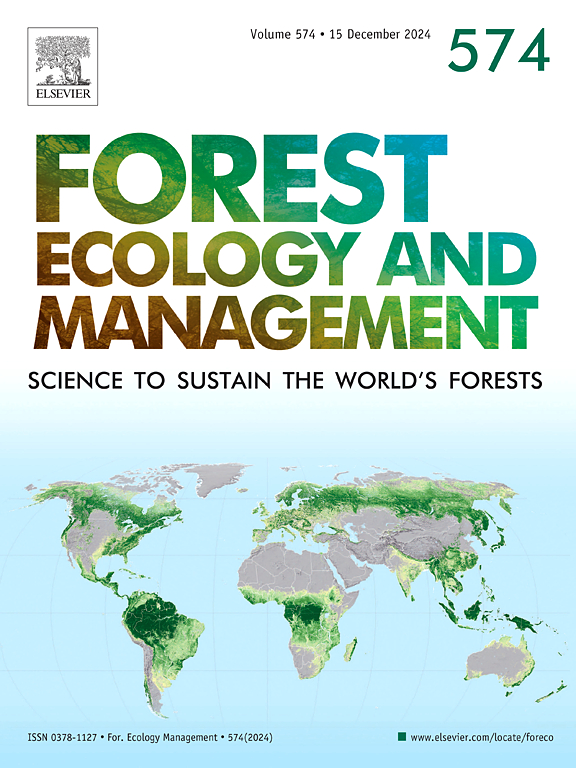入侵桃李。比本地树种拥有更多的地衣——数量反映质量吗?
IF 3.7
2区 农林科学
Q1 FORESTRY
引用次数: 0
摘要
外来树木对附生地衣多样性的影响是入侵生态学中最重要的知识空白之一。其中一个著名的入侵者是樱树。已被确定为一种迅速蔓延到森林生态系统的外来物种,可能影响附生地衣的多样性。摘要本研究的目的是为了确定定居在黑栎树皮上的地衣的分类和功能多样性是否与组成早期演替栎树角梁林的原生树木不同。研究人员在Białowieża国家公园周边对四种原生树木(桦树、椴树、栎树和白杨)和非原生树(胸径、胸高)的附生植物进行了调查。通过排序和线性回归分析发现,青苔属地衣的分类和功能多样性最高。结果表明,青苔和青苔的胸径增大与地衣分类和功能多样性呈正相关。同样,苔藓丰富度随着胸径的增加而增加,但我们没有发现地衣功能多样性与胸径的关系。这表明即使是小的油松个体也能支持高度的附生植物功能多样性,超过了本地树木。我们提供了新的证据,证明入侵树木对最少分析的依赖生物群体的影响,扩大了评估的非本地树木的功能和系统发育范围。在这种情况下,P. cerasifera似乎扮演了一个特定的功能,作为一个宿主,在转化的生态系统中恢复附生生物群特别重要。本文章由计算机程序翻译,如有差异,请以英文原文为准。
Invasive Prunus cerasifera Ehrh. hosts more lichens than native tree species – does quantity reflect quality?
The impact of nonnative trees on epiphytic lichen diversity is one of the most significant knowledge gaps in invasion ecology. One notable invader, Prunus cerasifera Ehrh., has been identified as a rapidly spreading nonnative into forest ecosystems, potentially influencing the diversity of epiphytic lichens. The objective of this study was to determine whether the taxonomic and functional diversity of lichens colonizing P. cerasifera bark differs from that observed on native trees composing early successional oak-hornbeam forest. We conducted our study in the surroundings of the Białowieża National Park by surveying epiphytes inhabiting four native trees (Carpinus betulus, Tilia cordata, Quercus robur, and Populus tremula), and non-native P. cerasifera, varying in diameter at breast height (DBH). Using ordination and linear regression, we found that P. cerasifera hosted the highest taxonomic and functional diversity of lichens. For Q. robur and T. cordata we observed a positive relationship between increasing DBH and lichen taxonomic and functional diversity. Similarly, the epiphyte richness increased with DBH in P. cerasifera, but we did not find any relationship between lichen functional diversity and DBH. This suggests that even small P. cerasifera individuals can support a high epiphyte functional diversity, surpassing that of native trees. We provided novel evidence of invasive tree impact on the least analysed group of dependent organisms, broadening functional and phylogenetic range of assessed nonnative trees. In this context, P. cerasifera appears to play a specific function as a host of particular importance for restoring epiphytic biota in transformed ecosystems.
求助全文
通过发布文献求助,成功后即可免费获取论文全文。
去求助
来源期刊

Forest Ecology and Management
农林科学-林学
CiteScore
7.50
自引率
10.80%
发文量
665
审稿时长
39 days
期刊介绍:
Forest Ecology and Management publishes scientific articles linking forest ecology with forest management, focusing on the application of biological, ecological and social knowledge to the management and conservation of plantations and natural forests. The scope of the journal includes all forest ecosystems of the world.
A peer-review process ensures the quality and international interest of the manuscripts accepted for publication. The journal encourages communication between scientists in disparate fields who share a common interest in ecology and forest management, bridging the gap between research workers and forest managers.
We encourage submission of papers that will have the strongest interest and value to the Journal''s international readership. Some key features of papers with strong interest include:
1. Clear connections between the ecology and management of forests;
2. Novel ideas or approaches to important challenges in forest ecology and management;
3. Studies that address a population of interest beyond the scale of single research sites, Three key points in the design of forest experiments, Forest Ecology and Management 255 (2008) 2022-2023);
4. Review Articles on timely, important topics. Authors are welcome to contact one of the editors to discuss the suitability of a potential review manuscript.
The Journal encourages proposals for special issues examining important areas of forest ecology and management. Potential guest editors should contact any of the Editors to begin discussions about topics, potential papers, and other details.
 求助内容:
求助内容: 应助结果提醒方式:
应助结果提醒方式:


